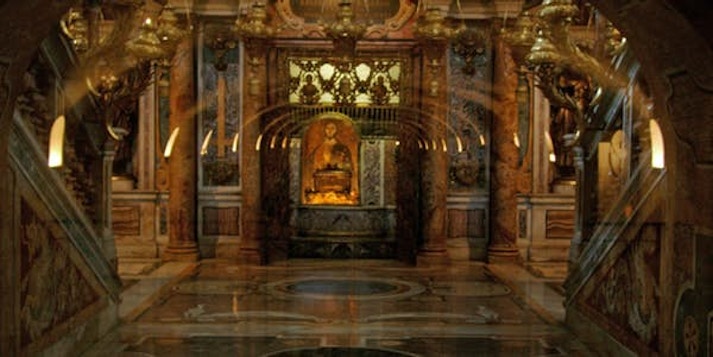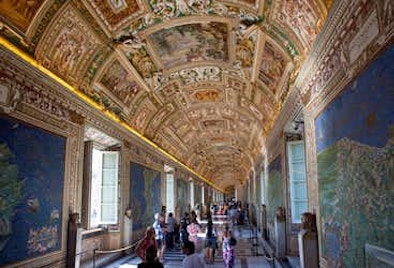- St. Peter's Basilica
- Grand Tomb of St. Peter
- Vatican Grottoes
- Vatican Museums
- St. Peter's Basilica Dome
- St. Peter's Square
- Sistine Chapel
- Vatican Necropolis
- History
- Architecture
- Inside
- Floor Plan
- Old St. Peter's Basilica
- St. Peter's Chair
- Statues
- St. Peter's Altar
- St. Peter's Baldacchino
- Saint Peter
- Plan Your Visit
- Skip the Line Tours
- Guided Tours
- Night Tours
- Timings
- Directions
- Entrances
- Facts
- Feast of the Chair of St. Peter
- Mass
- Dress Code
- Colosseum
- Vatican Museums
- Castel Sant Angelo
- Rome Pantheon
- Borghese Gallery
- Roman Catacombs Tour
- Bioparco Rome
- Big Bus Rome Hop-On Hop-Off Tickets
- Palazzo Barberini
- Musei Capitolini
- Leonardo da Vinci Museum
- Trevi Fountain Tours
- Roman Baths of Caracalla
- Palazzo Merulana
- Crypta Balbi
- Altare della Patria
- Rome Underground Tours
- Mamertine Prison
St Peter's Basilica | Vatican City | The Greatest Church in Christendom
St Peter’s Basilica is a phenomenal church located in Vatican City and is one of the most sought-after destinations in Rome. A classic example of Renaissance architecture, the c...
Founded On
1626
Quick information
RECOMMENDED DURATION
2 hours
Timings
7 AM - 7 PM
VISITORS PER YEAR
10000000
TICKETS
From € 24
NUMBER OF ENTRANCES
5
EXPECTED WAIT TIME - SKIP THE LINE
1-2 hours (Peak), 0-30 mins (Off Peak)
UNESCO YEAR
1984
Fun facts
St Peter’s Basilica, sits over what is presumed to be the tomb of St Peter, the Apostle of Jesus, and the first Pope executed by Emperor Nero. In fact right below the basilica, is the Vatican Necropolis, the remains of an ancient Roman burial ground with tombs dating back to the 1st and 4th centuries.
The Dome of the Basilica was designed by Michelangelo and was inspired by the Pantheon. The dome then went on to be the muse of many buildings including the Capitol in Washington and St Paul’s Cathedral in London.
There’s plenty to say about the dome but the sheer size of it is baffling. The height of the dome is 136.5 meters. Let us put that in perspective - it is so tall that you could fit the Statue of Liberty inside it!
Book St. Peter's Basilica Tours & Tickets
Architecture of St. Peter’s Basilica

The Basilica is built in traditional Renaissance and Baroque architecture and has been an inspiration for church buildings across the world. The basilica is accessed from St. Peter's Square, designed by Bernini. The oval forecourt is encircled by a Doric colonnade, which ends at the facade of Saint Peter's Basilica designed by Carlo Maderno. The facade features a giant order of Corinthian columns topped by statues.
The original plan by Bramante imagined superimposing the Pantheon on the Temple of Peace, taking the shape of a Greek cross. Michelangelo modified the plan to incorporate the massive dome, which stands as the tallest dome in the world.
St. Peter's Basilica Design & ConstructionWhat's Inside St. Peter's Basilica?
Inside the basilica you will find a series of priceless treasures in marble and bronze, papal tombs and several famous paintings.

Cupola
The St. Peter's Basilica Dome or the Cupola is one of the largest domes in the world. The design of the Dome is attributed to Michelangelo. However, the construction of the dome was completed only in 1590 by his pupil Giacomo Della Porta. The cupola has several elements across six concentric circles, including 16 large windows, busts, frescos, and figurines of over 96 figures. You can climb 231 steps or take the elevator to reach the base and climb up another 320 steps to reach the top of the cupola for unhindered views of the Vatican and Rome.
St. Peter's Basilica Dome Tickets
Michelangelo's Pieta
The Pieta is one of the most recognizable statues in the world and was created by the Italian Master Michelangelo. The Carrara marble structure depicts Jesus after his crucifixion in the lap of Mother Mary. Almost 6 feet in height, the sculpture towers and exudes a monumental aura that portrays the sanctity of the moment. Pieta roughly translates to Pity in English, is the only sculpture that was signed by Michelangelo and was created in the late 15th century. You can find this breathtaking statue in the first chapel on the right as soon as you enter St. Peter’s Basilica.

The Papal Altar
Designed by Gian Lorenzo Bernini, the Papal Altar is located at the center of Saint Peter's Basilica. Completed over a course of 11 years, the altar is surmounted by a bronze four-pillared canopy in a baroque style. The altar was built over the tomb of St. Peter, making the altar the most significant part of the church. Two main features of the Papal Altar are St. Peter’s Baldacchino and St. Peter’s Chair. It is here that the Pope performs Mass.
St. Peter's Altar
Statue of St. Longinus
The Statue of St. Longinus is located in a gallery ‘loggia’ at one of the crossings in the St. Peter’s Basilica. You will have to crane your neck to admire this statue that towers over 13 feet and was sculpted by Bernini. The evocative marble sculpture is of the Roman centurion, St. Longinus, who pierced Jesus with a lance but who converted to Christianity after Christ’s death. The statue was built in 1643 and took over four blocks of marble.

Bronze Statue of St. Peter
Placed against the pillar of St. Longinus is the famous statue of St. Peter, which dates back to the 5th century. It is one of the most important aspects of the Basilica. It depicts the saint sitting on a marble chair, holding the keys of heaven in his left hand, and is his right hand raised in the act of blessings. Pilgrims traditionally touch and kiss its foot; over the years, this has allowed the toes to be worn thin.
On 29 June, the feast of St. Peter, the statue is clothed with an amice, alb, tiara, stole, red cope, and a ring, while the pedestal is decorated using fine marble, Sicilian jasper, green porphyry, and the "marble of St. Peter".

The Confessio
The word 'Confessio' refers to the Confession of faith by St. Peter which lead to his martyrdom. The Confessio is a small altar created by Carlo Maderno directly in front of the tomb of St Peter. Accessible by a staircase, the semicircular altar is located on the same level as the Grottoes. The existence of a Confessio is believed to date back to when the ancient foundation of the basilica was laid. However, the altar in its present form was created during the time of Clement VIII, and for the most part to Paul V.

St. Peter’s Tomb
St. Peter was said to be crucified in Caligula’s Circus back in 64 C.E. and buried at a spot on the Vatican Hill. Later on, during the reign of Constantinople, a church was built on the tomb of St. Peter, which was later turned into the present St. Peter’s Basilica in the 16th century. Currently, the Confessio area is created in front of St. Peter’s Tomb to commemorate his martyrdom. The papal altar was created directly above the tomb, and several popes are buried below the tomb in the Vatican Necropolis. There is however a lack of consensus whether the tomb really contains the remains of St. Peter!
How to Visit St. Peter’s Tomb?
Vatican Grottoes
St. Peter’s Basilica is also the resting ground of several popes and historical figures and you can find their graves in the underground level known as the Vatican Grottoes. There are more than 100 such tombs, as well as chapels, dedicated to the popes and saints. These grottoes, or artificial caves, have elaborate designs and are decorated with frescos, sarcophagi, paintings, and inscriptions. The notable ones are the Chapel of St. Peter, the tomb of Christina of Sweden, the marble statue of St Peter enthroned, and the tomb of Queen Charlotte of Cyprus.
Who's Buried in the Vatican Grottoes?Frequently Asked Questions About St. Peter's Basilica
A. St. Peter's Basilica is a Rennaisance-style church located in Vatican City. Built above the burial site of St. Peter, the church is considered to be one of the holiest sites in Christiandom. It is also a cultural, historical, and architectural landmark.
A. St. Peter's Basilica was built between 1506 and 1626.
A. It took about 150 years to build St. Peter's Basilica.
A. Tickets to St. Peter's Basilica starts at €27.
A. St. Peter's Basilica is located at Piazza San Pietro, 00120 Città del Vaticano, Vatican City.
A. Eight artistes Donato Bramante, Antonio da Sangallo the Younger, Michelangelo, Giacomo Barozzi da Vignola, Giacomo della Porta, Carlo Maderno, Gian Lorenzo Bernini and Carlo Fontana were responsible for designing St. Peter's Basilica.
A. St. Peter's Basilica is not only the largest church in the world, but also the holiest shrine in Christendom as it has been erected over the tomb of Saint Peter. It is home to some beautiful and priceless statues, and artworks as well.
A. Inside St. Peter's Basilica you will find many Renaissance and Baroque masterpieces such as Michelangelo's Pietà, the statue of St. Longinus and the baldachin by Bernini.
A. St. Peter's Basilica is open from 7 AM to 6:30 Pm between 1 October to 31 March and from 7 AM to 7 PM between 1 April to 30 September.
A. St. Peter's Basilica was built to replace the dilapidated Old St. Peter's Basilica, which was built in the 4th century by Roman emperor Constantine the Great. It was built between 1506 and 1626.
A. Spread over 21,000 square meters, Peter's Basilica in Vatican City is the world's largest church.



